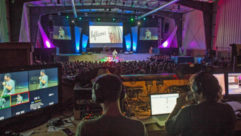Managing for church projection
Jan 1, 1999 12:00 PM,
Peter H. Putman
Churches, by nature, are environmentally hostile to projection. TraditionalCRT projection systems are no match for ambient light from outside and warmlight from sconces, scoop lights, down lights and stage lighting. It hastaken the evolution of lightvalve projectors (LCDs, DLP and ILA) togenerate sufficiently bright video images. Instead of 150 to 250 ANSIlumens, we now have 20x more light in a single projector. That extra lightenergy may expand the upper end of image grayscales, yielding brilliantwhites and bright colors, but the low end is still limited by ambient lightthat hits the screen surface.
Lighting with purposeThere are two lighting vs. projection conflicts. The first occurs whenlarge areas of a pulpit must be illuminated for better viewing of aminister. The second occurs when preset internal lighting effects are usedto create a dramatic mood for different services or different sections of aservice.
In both cases, light can spill onto a screen surface if not carefullyfocused, which can fog the image, lower contrast and make it harder forpeople in distant rows to see any image magnification (IMAG) video or keyedtitles and hymn lyrics. Ambient light from windows aggravates both problems.
When installing a large-screen display system, the most practical way toavoid these problems is to cycle through all existing lighting cues to seewhich backdrops or walls can remain unlit. Checking lighting cues andsetting all house lights to full on may reveal a better screen location.
You may discover that there are no ideal locations for a screen; in fact,existing stage wash and spotlighting may illuminate every wall surface. Inthis case, modifications will have to be made to use tighter spots, washeswith barn doors, extended snoots on down lights and occasional lightingflags.
If modifying lighting to accommodate a screen creates an asymmetrical lightpattern, a banner or similar backdrop lit with a glow light can balance outthe screen. A second projection screen may even be in order. Also, tryaccent lighting to either side of the screen.
The eye is drawn to the brightest object in a scene, so lighting cuesduring video segments should be preset to draw the eye to the minister orthe projection screen. Banners and floral decorations can glow during anIMAG or pre-recorded video segment; do not bring them up too high.
If the screen surface is offset from a background, provide a mid grayscalecolor for that background and softly light it to a dark gray. This workswell with projected images. Viewers will experience less eyestrain andfaster adjustment to full house lighting.
Lighting for depthAlthough our eyes are forgiving, the same can’t be said for video cameras.You must light the pulpit and any proscenium or stage areas to provide areasonable grayscale, avoiding any high-contrast lighting between subjectsand backgrounds.
Three-point lighting on any person not standing against a wall is a must.Ministers are generally downstage and should be lit to set them off fromany decorative backdrops. In addition, the areas behind them should notfade into blackness.
If we light a heavy drape behind a minister at a lectern, we may see only aslight difference in light intensity from foreground to background. A videocamera, however, will expand that contrast and see several f/stops of lightlevels between the minister’s face and the drapery. It may drop to almostblack.
As a rule of thumb, light any fixed areas with a key lamp, a fill at onef/stop lower and a hair light at one f/stop higher. Provide a backgroundabout two f/stops below the key light to prevent eye fatigue. This lightingwith moving subjects is difficult, so a stage wash with PAR-type lightingcans will be called for. Back light the subject from additional flood lampsand barn doors about one f/stop higher.
You will need a high angle for any back lights to prevent shining lightsdirectly into the audience’s eyes. If impossible, then extra barn doorswill be required. These will provide depth between foreground andbackground objects on IMAG images. Keep any wash lighting on sets, flats orbanners at two f/stops below the front wash lights.
Also, use light straw gels on focused lamps to reduce glare. Cameras willread all light ambers and straws as white once they are balanced totungsten lighting. Straw or cool blue gels additionally work for backlights and set/flat lighting. Light blue gels reduce contrast and colorsaturation, providing more definition and depth between the subject andbackgrounds.
You may run into tricky situations mixing ambient light and stage lighting,particularly if your church has a lot of high windows. In this case, usecooler (bluish) gels on many of your lights for correct white balance. Ifyou are ambitious, apply correction gels directly to certain windows tochange the color temperature of outside light.
Effective lighting for church projection is not all that complicated, butit does take practice to set lights and balance levels for the human eyeand video cameras. Experiment with room and stage lighting to see whichcombinations of settings and instruments give the best-looking projectedimages while providing a warm, intimate feeling.
Do not depend on the low-light settings on your cameras. They introducenoise and grain that looks worse when projected. Focused lights create morecontrast, and high contrast increases apparent sharpness in projectedimages. Contrast also punches up colors and createsdepth and space-all keysto getting the best image from the projection system.







